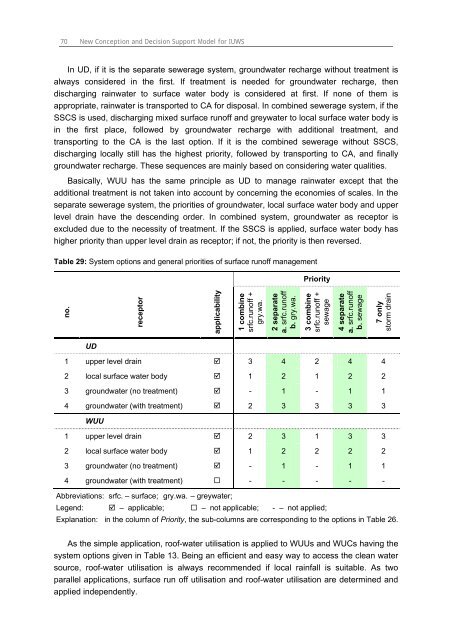Chapter 3 Decision Support Model (IUWS-DSM) - Tubdok
Chapter 3 Decision Support Model (IUWS-DSM) - Tubdok
Chapter 3 Decision Support Model (IUWS-DSM) - Tubdok
Create successful ePaper yourself
Turn your PDF publications into a flip-book with our unique Google optimized e-Paper software.
70 New Conception and <strong>Decision</strong> <strong>Support</strong> <strong>Model</strong> for <strong>IUWS</strong><br />
In UD, if it is the separate sewerage system, groundwater recharge without treatment is<br />
always considered in the first. If treatment is needed for groundwater recharge, then<br />
discharging rainwater to surface water body is considered at first. If none of them is<br />
appropriate, rainwater is transported to CA for disposal. In combined sewerage system, if the<br />
SSCS is used, discharging mixed surface runoff and greywater to local surface water body is<br />
in the first place, followed by groundwater recharge with additional treatment, and<br />
transporting to the CA is the last option. If it is the combined sewerage without SSCS,<br />
discharging locally still has the highest priority, followed by transporting to CA, and finally<br />
groundwater recharge. These sequences are mainly based on considering water qualities.<br />
Basically, WUU has the same principle as UD to manage rainwater except that the<br />
additional treatment is not taken into account by concerning the economies of scales. In the<br />
separate sewerage system, the priorities of groundwater, local surface water body and upper<br />
level drain have the descending order. In combined system, groundwater as receptor is<br />
excluded due to the necessity of treatment. If the SSCS is applied, surface water body has<br />
higher priority than upper level drain as receptor; if not, the priority is then reversed.<br />
Table 29: System options and general priorities of surface runoff management<br />
no.<br />
UD<br />
receptor<br />
applicability<br />
1 combine<br />
srfc.runoff +<br />
gry.wa.<br />
2 separate<br />
a. srfc.runoff<br />
b. gry.wa.<br />
Priority<br />
3 combine<br />
srfc.runoff +<br />
sewage<br />
4 separate<br />
a. srfc.runoff<br />
b. sewage<br />
1 upper level drain � 3 4 2 4 4<br />
2 local surface water body � 1 2 1 2 2<br />
3 groundwater (no treatment) � - 1 - 1 1<br />
4 groundwater (with treatment) � 2 3 3 3 3<br />
WUU<br />
1 upper level drain � 2 3 1 3 3<br />
2 local surface water body � 1 2 2 2 2<br />
3 groundwater (no treatment) � - 1 - 1 1<br />
4 groundwater (with treatment) � - - - - -<br />
7 only<br />
storm drain<br />
Abbreviations: srfc. – surface; gry.wa. – greywater;<br />
Legend: � – applicable; � – not applicable; - – not applied;<br />
Explanation: in the column of Priority, the sub-columns are corresponding to the options in Table 26.<br />
As the simple application, roof-water utilisation is applied to WUUs and WUCs having the<br />
system options given in Table 13. Being an efficient and easy way to access the clean water<br />
source, roof-water utilisation is always recommended if local rainfall is suitable. As two<br />
parallel applications, surface run off utilisation and roof-water utilisation are determined and<br />
applied independently.

















